Apollo 14: Third Manned Landing on the Moon
The Apollo 14 mission was a return to form, as the crew successfully got themselves to the Moon and back, performing a battery of experiments along the way, completing two long Moonwalks, and proving that golf balls can fly far in lower gravity. 
Commanding the expedition was the first American in space, Alan Shepard (left, center). The only member of Project Mercury to make it to the Moon, Shepard had been scheduled to fly on the first Gemini mission but was then grounded for four years because of the onset of Mèniére's disease, an inner ear disorder, and had finally undergone radical surgery that eliminated the condition. The Command Module Pilot was Stuart Roosa (left, left), a former Air Force fighter pilot who had served as Launch date was Jan. 31, 1971. Blastoff was late because National Aeronautics & Space Administration (NASA) officials had ordered a hold because of bad weather. It was the first such occurrence. (Apollo 12 had launched during a thunderstorm and sustained a lightning strike that did no damage.) The first hint of trouble came before the spacecraft left Earth orbit. The crew set about docking the Command Service Module (CSM), Kitty Hawk, and the Lunar Module, Antares but discovered that the docking latches didn't work. They tried five times without success, resorting to firing the CSM's thrusters in a burst that ended up nudging the two craft together and locking the latches. With that maneuver achieved, the crew settled in for a few days of space travel. 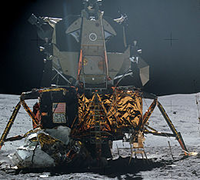
The crew and their craft entered lunar orbit on February 4, and Shepard and Mitchell climbed into Antares for the descent to the surface. They overcame two serious problems on the way down. First, a faulty switch flashed an abort signal. The crew knew that nothing was wrong because all of the other systems checked out, but they were concerned that another instance of an abort signal would initiate an automatic separation of the ascent module and the descent module; depending on when that happened, it could leave them stranded on the Moon. Scientists on the ground finally found a software workaround, and the descent continued. As well, the landing radar had a bit of a misadventure as well, refusing to zero in on the lunar surface. Running through a series of modifications, Shepard and Mitchell got the radar back online just in time. Shepard then took charge of the landing and touched the craft down in the Fra Mauro, closer to the intended target than any previous mission. It was the designated landing site for Apollo 13, which didn't include a lunar landing. 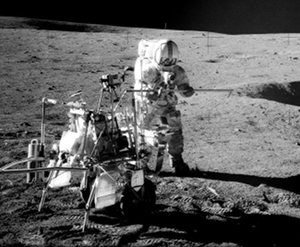
Shepard and Mitchell were on the surface of the Moon for 33 hours and did two sessions of extravehicular activity (EVA), totaling more than nine hours. They performed experiments similar to those done by previous crews, including setting up some that would remain when they left; this crew, however, had a pull cart for carrying equipment. The cart came in handy for towing things around and having supplies ready to hand, but it became a nuisance when the astronauts had to carry it over rough terrain. One of the goals of the second EVA to to reach the rim of Cone Crater, which was 1,000 feet tall. Because the slopes of the crater were so many, Shepard and Mitchell had to turn back because of low oxygen supply in their space suits before they reached the rim; later analysis showed that they were just 100 feet away from their goal. 
The crew brought back rocks from the lunar surface, including the famous Big Bertha, at 20 pounds the third-largest Moon rock retrieved; in 2019, scientists concluded that the rock was 4 billion years old and that it probably originated on Earth. 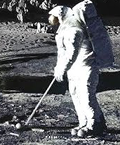
Just before they got back in the Lunar Module, the astronauts engaged in a bit of sports-related research. Shepard had brought two golf balls and the head of a 6-iron golf club, which he affixed to one end of a tool that he and Mitchell had been using for soil excavation. Shepard took one swing at each golf ball (using just one hand so as not to tip over in the bulky space suit) and connected both times, sending both balls flying through the air. Mitchell took his turn, throwing a tool as if it were a javelin. 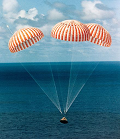
The rendezvous with Roosa, who had been taking photos and scouting the proposed landing site for Apollo 16 in the Command Service Module was uneventful, as were the trip home and the splashdown, the latter of which occurred on February 9 in the South Pacific Ocean. Apollo 14 was the last of the lunar landing crews to undergo quarantine. They were shut away for 17 days. 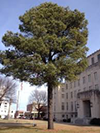
Roosa, who had an interest in forestry, took 50 tree seeds on the spaceflight. After the mission, the seeds were distributed around the world. |
|
Social Studies for Kids
copyright 2002–2025
David White



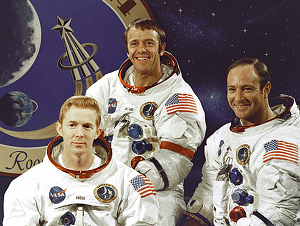 CapCom for
CapCom for 
